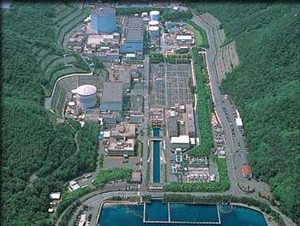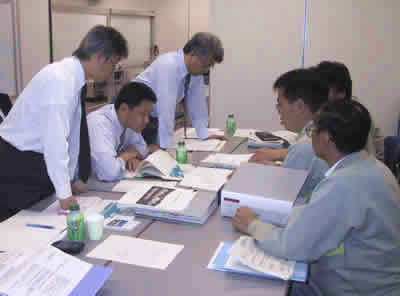 NSnet Peer Review of Tsuruga Power Station, The Japan Atomic Power Co, Inc, conducted over four-days period starting, May 11, was completed. A summary of the review is shown below. NSnet Peer Review of Tsuruga Power Station, The Japan Atomic Power Co, Inc, conducted over four-days period starting, May 11, was completed. A summary of the review is shown below.
|
1. Reviewed Establishment (location) |
|
 Tsuruga Power Station, The Japan Atomic Power Co., Inc., located in Tsuruga- shi, Fukui. Prefecture. Tsuruga Power Station, The Japan Atomic Power Co., Inc., located in Tsuruga- shi, Fukui. Prefecture. |
2. Overview of the establishment and targets of review |
|
 Tsuruga Power Station Unit 1 (Boiling Water Reactor with rated electric output of 357 MW) started commercial operation in March 1970 as the Japanese first commercial Light Water Reactor. Unit 2 (Pressurized Water Reactor with rated electric output of 1,160 MW) started commercial operation in February 1987. Unit 2 adopted a Pre-stressed Containment Concrete Vessel for the first time in Japan. Electricity generated at the power station is supplied to factories and houses via Chubu, Hokuriku, and Kansai Electric Power Companies. Tsuruga Power Station Unit 1 (Boiling Water Reactor with rated electric output of 357 MW) started commercial operation in March 1970 as the Japanese first commercial Light Water Reactor. Unit 2 (Pressurized Water Reactor with rated electric output of 1,160 MW) started commercial operation in February 1987. Unit 2 adopted a Pre-stressed Containment Concrete Vessel for the first time in Japan. Electricity generated at the power station is supplied to factories and houses via Chubu, Hokuriku, and Kansai Electric Power Companies. |
3. Members of the review team and the method of review
Group A
|
: |
Ishikawajima-Harima Heavy Industries Co., Ltd, Kyushu Electric Power Co., Inc.,
(Fields of review: organization/operation, emergency measures and education/training) |
| Group B |
: |
The Tokyo Electric Power Co., Inc., Sumitomo Metal Mining Co., Ltd.
(Fields of review: operations/maintenance) |
| Group C |
: |
Nuclear Fuel Industries, Ltd. NSnet
(Fields of review: radiation protection and handling of important issues) |
| Method of review |
: |
Field observation, interview with persons involved in and examination of documents in the above areas |
|
|
 Tsuruga Power station,
Tsuruga Power station, |
 Document examination
Document examination |
|
|
4. Results of this review
|
 (1) Main Conclusions (1) Main Conclusions |
|
• |
In summing up this review of Tsuruga Power Station, we have not found any item in the nuclear safety field that would lead to a serious accident unless immediate remedies were taken. |
|
• |
It was confirmed that all employees in the Station made concerted, earnest and serious efforts to continue and enhance nuclear safety under the plant manager’s policy of “Safety should be the highest priority in nuclear power stations. In addition, plant employees should work on plant management for stable and economical operation and good relationships with local communities”. |
|
• |
The Station developed various activities for the safety-focused month and performed activities concerning human factors, emphasizing communication between the plant senior staff and, the plant employees and contractors in order to improve safety awareness and create a workplace that enables good communication. |
|
• |
The Station had two types of reactors (PWR and BWR) and paid attention to ensuring safety during periodic inspections. |
|
• |
In the future, it is desired that Tsuruga Power Station should increase its own safety efforts toward enhanced safety culture, without accepting things as they are. |
 (2) Good Practices and Suggestions for Improvement (2) Good Practices and Suggestions for Improvement |
| |
 This Peer Review selects good practices that should be widely introduced to other NSnet members and within the nuclear power industry.On the other hand, this Peer Review makes numerous suggestions for improvement that would be useful in improving the safety culture at Tsuruga Power Station that were the focus of the Peer Review. This Peer Review selects good practices that should be widely introduced to other NSnet members and within the nuclear power industry.On the other hand, this Peer Review makes numerous suggestions for improvement that would be useful in improving the safety culture at Tsuruga Power Station that were the focus of the Peer Review.
 A brief look at Good Practices*¹ and Suggestions for improvement*² follows below. A brief look at Good Practices*¹ and Suggestions for improvement*² follows below. |
|
 a. Good Practices a. Good Practices
|
Fields of review |
Summary of good practices |
Organization / Administration |
| • |
Notification of policies through preparation and distribution of a periodic inspection handbook |
| • |
Smooth communication with staff from contractors during regular inspections through “GO-GO Campaign” |
| • |
Implementation of meetings between the plant manager and staff |
| • |
Addressing “Today’s Message” from senior staff |
| • |
Preparation of work procedures with countermeasuresagainst “one error” |
| • |
Ten safety instructions for each section |
| • |
Awards system for contractors |
|
Emergency measures |
| • |
Periodical training for incident reporting |
|
Education / Training |
| • |
Effective use of small simulator |
|
Operations / maintenance |
| • |
Reminder prior to works through KY (risk prediction) activities at ashift take over |
| • |
Discussions about revision of operation procedures from diversified viewpoints |
| • |
Ensured staff familiarization of company rules and procedures |
| • |
Prevention of human errors using check sheets colored according to the work importance classification |
| • |
Introduction of emergency shiftmanager support system, anomaly symptom detection support system (PATDAS) and system isolation support system (TOMMCAT) |
| • |
Enhancement of safety awareness (deep understanding of “TIMES” throughout all staff) |
| • |
Self-implementation of maintenance works, and in-house alliance of maintenance staff |
| • |
Seating chartswith facial portraits of the plant staff for contractors to discriminate easily |
| • |
Control of overworks due to reduction ofperiodical inspection period and increase of maintenance work |
| • |
Good communication with contractors |
|
Radiation protection |
| • |
Usage of check sheets for reducing exposure per task |
| • |
Reporting and communication system involving contractors during periodical inspections |
| • |
Effective dose control through development and practical application of electronic dosimeters |
| • |
Proactive public announcement of development of electronic dosimeters |
| • |
Reduction of radioactive solid waste generated in concert with contractors |
|
Handling of important issues |
| • |
Activities for human error prevention during periodical inspections |
| • |
Portable procedures for human error prevention |
|
|
|
 b. Suggestions for Improvement b. Suggestions for Improvement
|
Fields of review |
Summary of Suggestions for Improvement |
Radiation protection |
| • |
Method for protecting exposure dose data |
|
Handling of important issues |
| • |
Effective utilization of lessons learned form “near miss” cases |
|
|
|
|
|
*1 : Good Practices
 Information on good practices incorporating appropriate, effective, and unique methods into activities to ensure safety should be widely distributed to the members of the NSnet and the nuclear industry. Information on good practices incorporating appropriate, effective, and unique methods into activities to ensure safety should be widely distributed to the members of the NSnet and the nuclear industry.
*2 : Suggestions for Improvement
 After comparing the practices of Tsuruga Power Station with the best in the nuclear industry, suggestions to improve and enhance safety activities should be implemented to achieve the highest level of nuclear safety. After comparing the practices of Tsuruga Power Station with the best in the nuclear industry, suggestions to improve and enhance safety activities should be implemented to achieve the highest level of nuclear safety.
 Even if current activities are equal to or higher than general standards in the nuclear industry, suggestion is taken up in case there is still room for improvement. Even if current activities are equal to or higher than general standards in the nuclear industry, suggestion is taken up in case there is still room for improvement.
|
|







